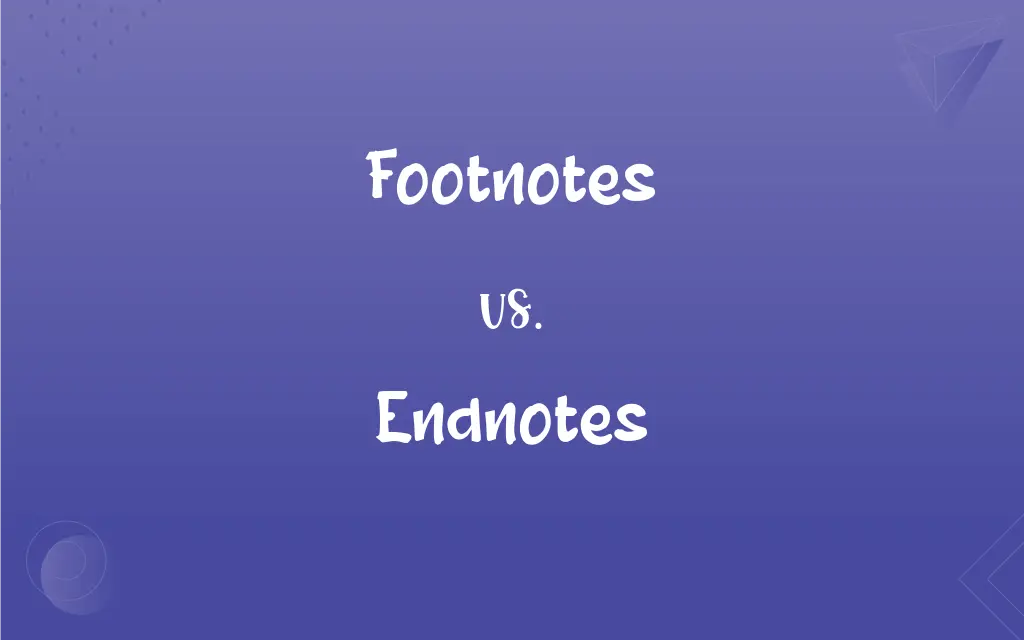Footnotes vs. Endnotes: What's the Difference?
Edited by Harlon Moss || By Janet White || Published on December 24, 2023
Footnotes appear at the bottom of each page, offering immediate reference, while endnotes are grouped at the end of a chapter or document, providing a less interrupted reading flow.

Key Differences
Footnotes are annotations or references placed at the bottom of the page where the reference occurs, providing instant access to additional information. Endnotes, in contrast, are collected at the end of a chapter or the document, making them less immediately accessible but keeping the page less cluttered.
Footnotes are convenient for readers who seek immediate clarification or additional data without leaving the page, while endnotes are useful for extensive comments or citations that might detract from the flow of the main text.
Footnotes are often preferred in academic papers for brief explanatory notes or citations, as they allow the reader to easily view the reference. Endnotes, however, are favored in books or longer works to consolidate all references and notes in one place for easier overall access.
The use of footnotes can sometimes disrupt the visual flow of a page, especially if numerous or lengthy. Endnotes, by being placed at the end, avoid this issue, providing a smoother reading experience but at the cost of immediate access to the information.
In terms of formatting, footnotes are typically numbered consecutively throughout a chapter or paper. Endnotes, while also numbered, are organized in a separate section, often just before the bibliography or index in a book.
ADVERTISEMENT
Comparison Chart
Location
Bottom of each page
End of a chapter or document
Reader Access
Immediate
At end, requires flipping pages
Visual Impact
Can clutter the page
Keeps pages uncluttered
Usage Preference
Favored for brief notes or citations
Preferred for extensive comments or numerous references
Numbering
Numbered consecutively on each page
Numbered consecutively in their own section
ADVERTISEMENT
Footnotes and Endnotes Definitions
Footnotes
Footnotes offer clarifications or acknowledgments.
This theory was first proposed in 19844.
Endnotes
Endnotes provide supplementary information or citations at the document's end.
This event sparked much debate among historians21.
Footnotes
Footnotes provide extra information, references, or citations.
The economic impact was significant2.
Endnotes
Endnotes are used for extensive notes or bibliographic details.
A detailed analysis is provided in Appendix A22.
Footnotes
A footnote is a note at the bottom of a page in a book or document.
The term 'Renaissance' is complex1.
Endnotes
Endnotes are used to avoid cluttering the text with footnotes.
This aspect is further elaborated in the final section24.
Footnotes
Footnotes are supplementary notes to the main text.
He was a controversial figure in his time3.
Endnotes
An endnote is a reference or comment at the end of a document.
Several studies support this theory20.
Footnotes
Footnotes serve to cite sources or provide related readings.
Further details are available in Smith's work5.
Endnotes
Endnotes offer comprehensive references for in-depth study.
For a full list of sources, see Endnote 2323.
Footnotes
A note placed at the bottom of a page of a book or manuscript that comments on or cites a reference for a designated part of the text.
Endnotes
A note at the end of an article, chapter, or book that comments on or cites a reference for a designated part of the text.
Footnotes
Something related to but of lesser importance than a larger work or occurrence
A political scandal that was but a footnote to modern history.
Endnotes
Plural of endnote
Footnotes
To furnish with or comment on in footnotes.
Footnotes
Plural of footnote
Footnotes
Infl of footnote
FAQs
Can footnotes include citations?
Yes, footnotes often include citations or source references.
Are endnotes common in academic writing?
Endnotes are less common but used in academic works for extensive citations.
Can footnotes include opinions?
Footnotes can include brief comments, opinions, or clarifications.
Are endnotes disruptive to readers?
No, endnotes are less disruptive as they don't clutter the page.
What are footnotes?
Footnotes are notes at the bottom of a page providing additional information or citations.
Where are endnotes located?
Endnotes are located at the end of a chapter or document.
When should I use footnotes?
Use footnotes for immediate references or brief explanatory notes.
Can I convert footnotes to endnotes?
Yes, most word processors allow conversion between footnotes and endnotes.
Why prefer endnotes over footnotes?
Endnotes are preferred to avoid page clutter and for extensive referencing.
Is it easy to reference footnotes while reading?
Yes, footnotes are easily referenced as they appear on the same page.
Do footnotes distract from the main text?
They can, especially if lengthy or numerous.
Are endnotes helpful in keeping a narrative flow?
Yes, endnotes help maintain narrative flow by removing in-page distractions.
Do endnotes affect the document's length?
Yes, endnotes can significantly increase the length of a document.
How do I cite sources in endnotes?
Use the same citation style as in the main text, placed in endnotes.
Can footnotes and endnotes coexist in a document?
Yes, though it's unusual and can be confusing for the reader.
Can I omit footnotes in a summary?
Yes, if they are not critical to the understanding of the summary.
Should endnotes be considered for online articles?
It depends, but hyperlinks are often more convenient in online texts.
How are footnotes numbered?
Footnotes are usually numbered consecutively throughout a document.
Should footnotes be detailed?
Footnotes are typically brief; detailed notes are better as endnotes.
Are endnotes included in word counts?
This depends on the guidelines of the document or publication.
About Author
Written by
Janet WhiteJanet White has been an esteemed writer and blogger for Difference Wiki. Holding a Master's degree in Science and Medical Journalism from the prestigious Boston University, she has consistently demonstrated her expertise and passion for her field. When she's not immersed in her work, Janet relishes her time exercising, delving into a good book, and cherishing moments with friends and family.
Edited by
Harlon MossHarlon is a seasoned quality moderator and accomplished content writer for Difference Wiki. An alumnus of the prestigious University of California, he earned his degree in Computer Science. Leveraging his academic background, Harlon brings a meticulous and informed perspective to his work, ensuring content accuracy and excellence.































































